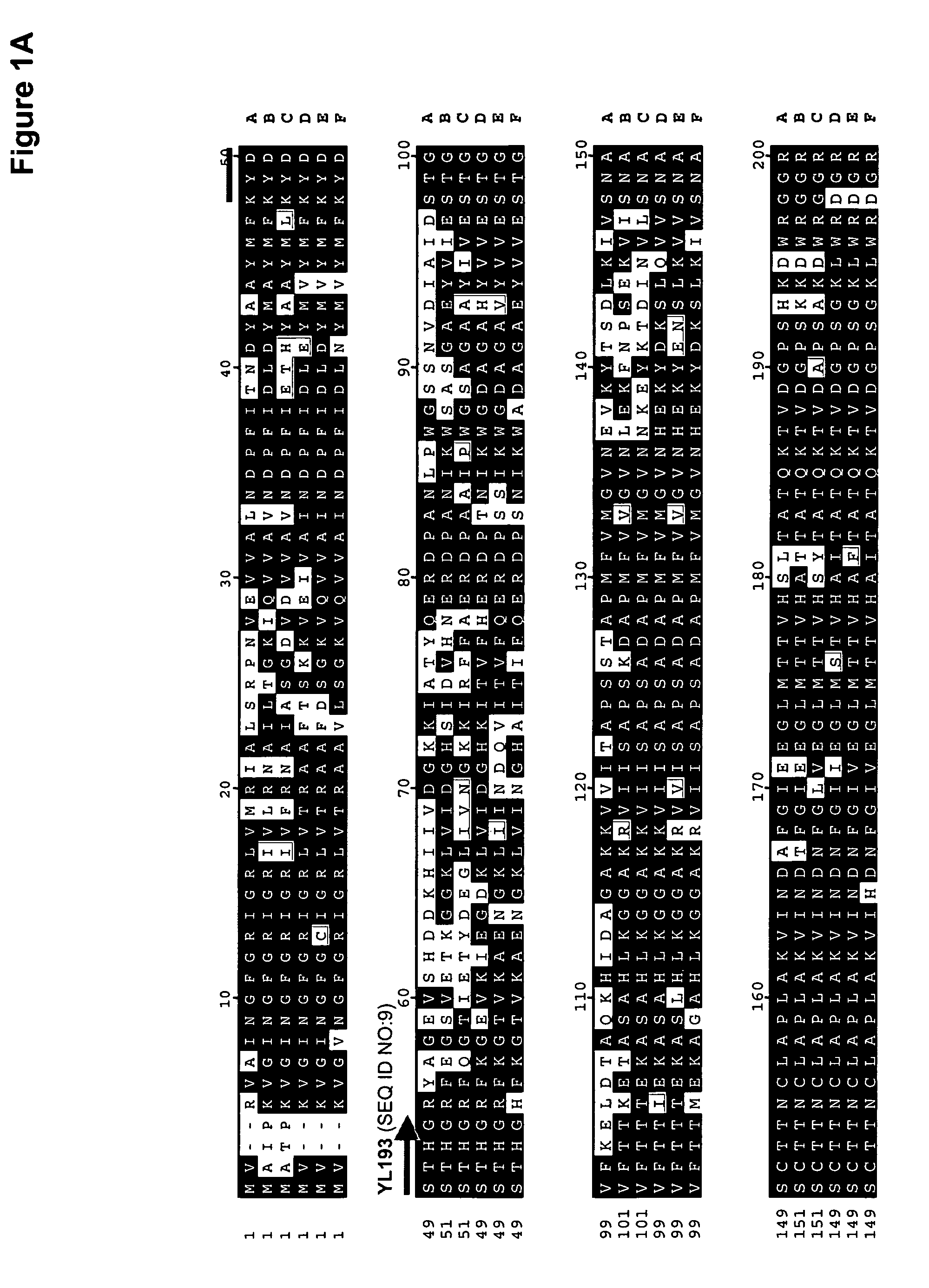Glyceraldehyde-3-phosphate dehydrogenase and phosphoglycerate mutase regulatory sequences for gene expression in oleaginous yeast
- Summary
- Abstract
- Description
- Claims
- Application Information
AI Technical Summary
Problems solved by technology
Method used
Image
Examples
example 1
Isolation of a Portion of the Yarrowia lipolytica Glyceraldehyde-3-phosphate dehydrogenase (“GPD”)
[0210] The present Example describes the identification of a portion of the Yarrowia lipolytica gene encoding GPD (SEQ ID NOs:11 and 12), by use of primers derived from conserved regions of other GPD sequences.
[0211] A comparison of the various GPD protein sequences encoding gpd genes from Saccharomyces cerevisiae (GenBank Accession No. CM24607; SEQ ID NO:1), Schizosaccharomyces pombe (GenBank Accession No. NP—595236; SEQ ID NO:2), Aspergillus oryzae (GenBank Accession No. MK08065; SEQ ID NO:3), Paralichthys olivaceus (GenBank Accession No. BM88638; SEQ ID NO:4), Xenopus laevis (GenBank Accession No. P51469; SEQ ID NO:5) and Gallus gallus (GenBank Accession No. DECHG3; SEQ ID NO:6) showed that there were several stretches of conserved amino acid sequence between the 6 different organisms (FIGS. 1A and 1B). Thus, two degenerate oligonucleotides (shown below), corresponding to the conse...
example 2
Identification of the Yarrowia lipolytica Phosphoglycerate Mutase (GPM)
[0216] The present Example describes the identification of the Yarrowia lipolytica gene encoding GPM, by use of a S. cerevisiae GPM protein sequence as a query sequence against a Y. lipolytica genomic database.
[0217] Specifically, the S. cerevisiae GPM protein sequence (GenBank Accession No. NP—012770; SEQ ID NO:13) was used in BLAST searches (as described in Example 1) against the public Y. lipolytica database of the “Yeast project Genolevures” (sponsored by the Center for Bioinformatics, LaBRI, bâtiment A30, Université Bordeaux 1, 351, cours de la Libération, 33405 Talence Cedex, France).
[0218] One contig (“Contig 2217”; SEQ ID NO:14) was identified that encoded GPM in Y. lipolytica. Contig 2217 is 1049 bp in length, although 5 nucleotide positions had ambiguous sequence (having an “n” at nucleotide position 1020, “y” at positions 39, 62, 331; and a “m” at position 107). The DNA sequence of Contig 2217 was t...
example 3
Isolation of the 5′ Upstream Regions of the gpd and gpm Genes From Yarrowia lipolytica
[0221] To isolate the GPD and GPM regulatory sequences from the genes identified in Examples 1 and 2, a genome-walking technique (TOPO® Walker Kit, Invitrogen, Calif.) was utilized.
[0222] Briefly, genomic DNA of Y. lipolytica was digested with KpnI, SacI, SphI or PacI, and dephosphorylated with Calf Intestinal Alkaline Phosphatase (CIP), separately. Primer extension reactions were then carried out individually using the dephosphorylated DNA as template and one of the following oligonucleotides as primer: YL206 (SEQ ID NO:17) for GPD and YL196 (SEQ ID NO:18) for GPM. The primer extended products were linked with TOPO® linker and used as templates for the first PCR reactions using primers of LinkAmp Primer1 and a second appropriate oligonucleotide. Specifically, YL207 (SEQ ID NO:19) was used as the second primer targeted for the upstream promoter region of GPD and YL197 (SEQ ID NO:20) was used as t...
PUM
| Property | Measurement | Unit |
|---|---|---|
| Fraction | aaaaa | aaaaa |
| Fraction | aaaaa | aaaaa |
| Fraction | aaaaa | aaaaa |
Abstract
Description
Claims
Application Information
 Login to View More
Login to View More - R&D
- Intellectual Property
- Life Sciences
- Materials
- Tech Scout
- Unparalleled Data Quality
- Higher Quality Content
- 60% Fewer Hallucinations
Browse by: Latest US Patents, China's latest patents, Technical Efficacy Thesaurus, Application Domain, Technology Topic, Popular Technical Reports.
© 2025 PatSnap. All rights reserved.Legal|Privacy policy|Modern Slavery Act Transparency Statement|Sitemap|About US| Contact US: help@patsnap.com



